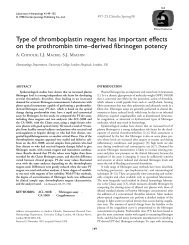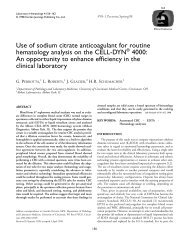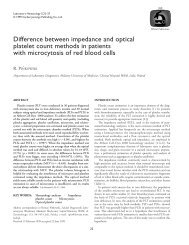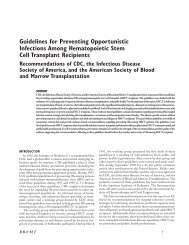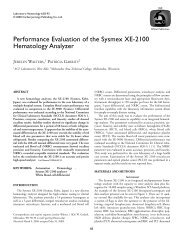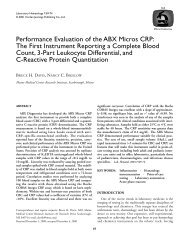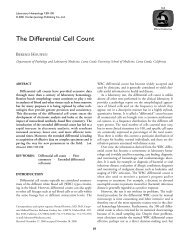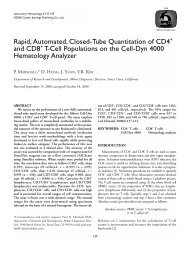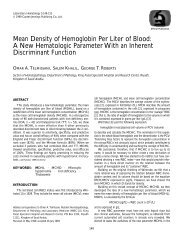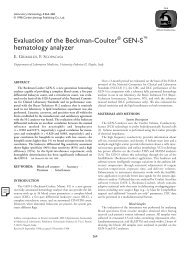Mean density of hemoglobin per liter of blood - Carden Jennings ...
Mean density of hemoglobin per liter of blood - Carden Jennings ...
Mean density of hemoglobin per liter of blood - Carden Jennings ...
Create successful ePaper yourself
Turn your PDF publications into a flip-book with our unique Google optimized e-Paper software.
2 OA Telmissani et al.<br />
evaluation <strong>of</strong> the common clinical hematologic problem <strong>of</strong><br />
hypochromic microcytosis: how to discriminate between iron deficiency<br />
anemia (IDA) and thalassemia trait (TT). In common clinical<br />
practice, differentiation is based on the demonstration <strong>of</strong><br />
reduced serum iron, increased total iron-binding capacity, or<br />
reduced serum ferritin (for IDA). For identifying TT or normal<br />
iron status, estimation <strong>of</strong> <strong>hemoglobin</strong> (eg, by electrophoresis) is<br />
required. However, these diagnostic procedures are not inexpensive,<br />
especially when, in addition, α-thalassemia trait (α-TT) is considered.<br />
In some cases, it may require globin-chain synthesis rate<br />
determination or even α-globin gene analysis may be required.<br />
To measure the efficacy <strong>of</strong> MDHL, we challenged it against several<br />
formulas that have been proposed to differentiate between IDA<br />
and TT. First, England and Fraser [4,5] introduced a linear discriminant<br />
function (DF) derived from the MCV, RBC count (RBCC),<br />
and <strong>hemoglobin</strong> (Hb) concentration. DF was <strong>of</strong> the form MCV –<br />
RBCC – (5 × Hb) – k, where k is a constant determined by the<br />
method used to calibrate the cell counter. Positive DF values indicate<br />
IDA and negative values indicate TT. Mentzer [6] suggested that an<br />
even simpler index, MCV/RBC, was equally useful for distinguishing<br />
the 2 conditions, with values below 13 indicating TT. Shine and Lal<br />
[7] used (MCV) 2 × MCH in screening for TT, with values <strong>of</strong> less<br />
than 1530 being regarded as diagnostic <strong>of</strong> the condition.<br />
Another formula is the discrimination score (DS), [8] based on<br />
the following equation:<br />
(0.096 × MCV) + (0.415 × RDW) – (0.139 × RBC) – 12.722 for men,<br />
and (0.096 × MCV) + (0.415 × RDW) – 12.722 for women,<br />
where RDW indicates red cell distribution width, with 0.3095 as<br />
a cut<strong>of</strong>f point, below which TT is probable and above which IDA<br />
is likely. Unfortunately, all <strong>of</strong> these approaches have significant<br />
limitations. First, their incorporation in the complete <strong>blood</strong> cell<br />
(CBC) hemogram is impractical because the mathematical procedures<br />
are elaborate. Second, their sensitivity and specificity are<br />
not high, resulting in considerable imprecision in discriminating<br />
between IDA and TT.<br />
MATERIALS AND METHODS<br />
The patients, retrospectively selected randomly, were older than<br />
12 years with microcytic hypochromic <strong>blood</strong> picture, Hb >70 g/L<br />
and MCV




